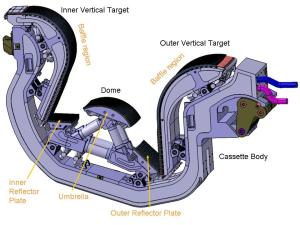ITER divertor under final review
Last week about 50 experts from the ITER Organization, the Domestic Agencies concerned (Europe, Japan, Russia) plus additional experts met in Cadarache to review the design of the ITER divertor. Section Leader Mario Merola summarizes the outcome of the three-day meeting.
Newsline: What were the main issues addressed in the review?
Merola: The divertor final design review addressed a wide range of topics. The design requirements, the design solutions, the supporting analysis, the manufacturing technologies as well as the remote handling and assembly procedures.
Is it possible to summarize the outcome? Was there general acceptance of the design or are there requests for changes? If so, what needs to be looked at again?
We arrived at the design review with all the 3D CATIA models and the 2D "built to print" drawings in the so-called "in check" status. This is the highest possible level of maturity for a review process. The system requirements document of the divertor and all interfaces were completed and already discussed with the various responsible officers. The final report of the review panel will be issued soon, however I can anticipate that there was a general acceptance of the proposed design. We have also received congratulations from the panel Chairman (Rene Raffray, University of California, San Diego, US) and the Deputy Director-General for the Tokamak Department (Gary Johnson).
The divertor has interfaces with almost twenty different systems, which have different levels of maturity and different schedules. As a consequence, we had to closely interact with the concerned responsible officers to develop a divertor design, which has a low probability to require changes, due to the future development of all these interfacing systems. In this respect, it should be pointed out that, if one waits to start the manufacturing of a component until all the other systems around it are finalized and frozen, ITER construction never starts. The "zero risk" of a design change in an experimental project is a dream that should not be pursued.
As regards the divertor, the most challenging interface is with remote handling. Large gaps would be desirable for an easy remote installation of this component, but this conflicts with the neutronic requirement and with the limited space, which is available. Remote handling is one of the most challenging issues of all the internal components, and not only of the divertor, and adequate resources and priority should be put in this critical field.
What is the further process now with regards to the Procurement Arrangement signature? Is another meeting necessary to look at the issues discussed?
The next steps include the finalization of the main text, annex A and annex B of the divertor Procurement Arrangement as well as agreement on a detailed construction schedule. These documents already exist and have been discussed with the Domestic Agencies involved (Europe, Japan and Russia). Their final draft will be ready before the end of the year. Besides that, some paperwork needs to be completed to update the divertor baseline documentation. The target is to have everything ready by February 2009.
Even if the final report of the design review panel has not yet been issued, I do not expect major issues, which require another meeting prior to signing the Procurement Arrangements for the divertor plasma-facing components.
To give an image of what the ITER divertor will look like, what would you say are the main features?
The ITER divertor (see attached picture) consists of a cassette body, which holds three plasma-facing components, namely the inner and outer targets and the dome. The targets intercept the magnetic field lines, and therefore remove the heat load coming from plasma via conduction, convection and radiation. The heat flux onto these components can reach a value, which is an order of magnitude higher than the heat flux in the core of a PWR fission reactor and more than 10,000 times higher than the maximum solar radiation in summer in south of Europe. During a plasma off-normal event, like a slow downward vertical displacement event, in which the plasma slips downward, the forces acting on the whole divertor can be as high as the weight of one hundred cars. This gives an idea of the engineering challenge ...


